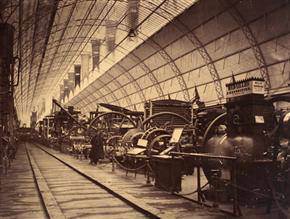
Charles Thurston Thompson
English, 1816-1868
French Machinery, 1855
The Metropolitan Museum of Art, New York, Purchase, The Horace W. Goldsmith Foundation Gift, through Joyce and Robert Menschel, 1992 (1992.5030)
Napoleon III and Paris – Metropolitan Museum
Napoleon III and Paris, on view at The Metropolitan Museum of Art from June 9 through September 7, 2009, portrays the quickly changing cityscape of Second Empire Paris through a presentation of 40 photographs and 13 works in other media, all drawn from the permanent collection
]]>
The exhibition begins with an introduction to the Imperial family. Nephew of Napoleon I, Louis-Napoleon Bonaparte was elected president of the French Second Republic after the Revolution of 1848 and the abdication of King Louis-Philippe. In 1851, Louis-Napoleon staged a coup d’état and seized dictatorial powers; one year later, he dissolved the Republic and established the Second Empire, taking the title Emperor Napoleon III.
This first section of the exhibition includes portraits of Louis-Napoleon in 1852 and Empress Eugénie in 1855 by Gustave Le Gray—the central figure in French photography of the 1850s—and a touching and unique portrait of the empress and her six-year-old son by Benjamin Delessert from 1862. A sculpted bust of the emperor by Jean-Baptiste Carpeaux and a painting of the empress by Franz Xaver Winterhalter, also from the collection, are featured as well.
Napoleon III’s ascension to power paralleled a dramatic flourishing of photography in France: the rise of paper photography over daguerreotypy; the development of new processes, including glass negatives; and the establishment of photographic societies, publications, and annual salons. Photographers also enjoyed direct encouragement from the emperor and his government in the form of commissions to record historic architecture and new construction, appointments as “official photographer” for the City of Paris or for specific public works, and purchases of photographs for imperial residences and municipal libraries.
Old Paris
Under Napoleon III and his prefect of the Seine, Baron Haussmann, Paris took the shape that is so familiar to us today. The grands boulevards, the limestone apartment buildings, and the public parks that form our image of Paris are largely the result of Napoleon III’s rebuilding of the capital in the 1850s and 1860s. The modern city came at a cost, however; historic buildings and whole neighborhoods were razed to make way for broad thoroughfares and grand public works. This profound transformation of the landscape of Paris provided subject matter for many of the period’s greatest photographers. Key among them was Charles Marville, official photographer to the City of Paris, who was commissioned to record the older areas of the capital that were slated for demolition. These photographs of a Paris that has long since disappeared are accompanied by contemporaneous etchings by Charles Meryon and Maxime Lalanne
Follow us on:

